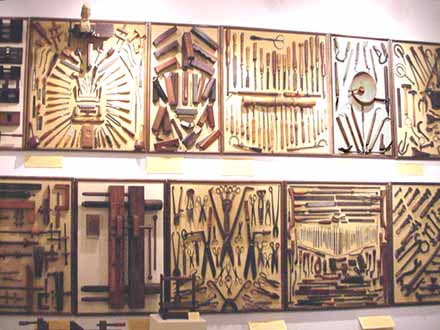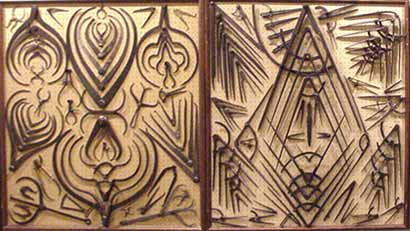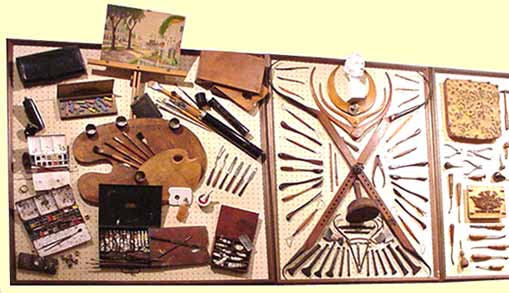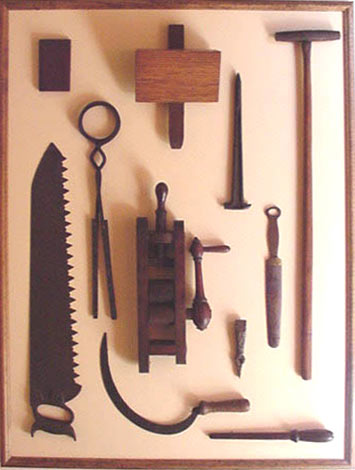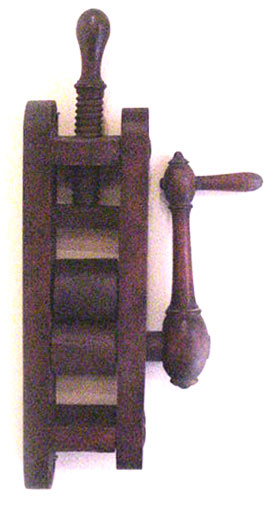29¼" overall length
1⅛" diameter of handle at center
1⅜" wide interior of 'D-handle'
(wide enough for a two-finger grip)
5" long prongs
1" between prongs at tips
The tool is made of a smoothed fine-grained wood, with only minor surface scratches.
The crosspiece of the handle and the area just above where the two prongs fork-off are reinforced with a steel pin through the wood. The ends of the pins are riveted over copper washers that are recessed slightly into the surrounding surface of the wood.
The only signs of wear are on the ends of the two prongs, which are mushroomed-out from having been struck against something with repeated light to medium blows.
Alan Sellars was a businessman who had a passion for collecting. He and his wife Louise collected antiques and artwork for over fifty years. They collected household furnishings and kitchen implements to fine paintings and antique hand tools.
After Alan had been collecting the tools for almost thirty years, he began building panels to arrange and display the collection that was at the time just stored in boxes in his workshop. He wanted to exhibit his collection to the public, and they were arranged and displayed hanging above the aisles in the family hardware store.
About ten years later the entire collection was exhibited in a large Atlanta gallery. A highlight of the exhibit was when Alan's friend Roy Underhill, the Woodwright from Colonial Williamsburg, felled a large poplar tree and hewed it into a twelve-foot long square timber using two axes and an adze while the surrounding crowd in formal dress sipped champagne.
ONE MAN'S PASSION . . .
Seven of the one-hundred-and-fourteen tool display panels on the walls of the Sellars' TOOLS OF THE TRADES collection of antique hand tools in the Bennet History Museum at the Funk Heritage Center, Waleska, Georgia.
The complete panels as shown are: (left to right, top row) Woodcarver's tools, Whetstones, Turner's Tools, and Bowl Maker's Tools; (left to right, bottom row) Bookbinder's Plough and Vise, Assorted Shears, and Assorted Files, Floats, and Rasps.
Over the next few years Alan continued to acquire tools for new displays, constantly revising panels and adding to others, but his work was never to be finished. After Alan passed away his collection was given by Louise to help create the museum at Reinhardt College.
Alan and Louise felt that the tools represent the love and care of the craftsmen who used them. Alan's passion for these tools came from his feeling that they are living pieces of history to be held in the hand.
Together Alan and Louise gave us a part of our own heritage, preserved and presented so that we might see a glimpse of the everyday workings of the past.
Two panels showing the Calipers
(on left)
and the
Metal Dividers
or Compasses
(on right)
 | ||||||
The Artist's Tools display (above left) and the Sculptor's Tools (above center), and part of the Wood Block Maker's Tools display (at right)
 | ||||
 | ||||
 | ||||
home / about the artist / stoneboat series / lipwork series / metaphorical presences / landscapes / multi-element installation pieces / recent works
technical processes / thumbnail galleries / Cortona foundry / Finland stone carving / recommended reading / all in the family / links page
 | ||||
 | ||||||
whatsits
If you, as a tool enthusiast, come across a tool that cannot be readily identified even after researching the books and catalogs on the library shelf, the tool is a "whatsit."
The purpose of the tool might be completely baffling to you, like a puzzle or a riddle that cannot be solved. Sometimes the general purpose of the tool might be obvious, but the specific purpose might elude you — for instance the tool might obviously be a hammer, but what was this particular hammer designed to hit?
The image at right shows the eleven tool panel of whatsits on display at the museum. Can you figure out what they are?
Below is a detail of one of them:
If you think you know what it is, email me and I will confirm or deny your identification and let you know what it was used to make.
The Whatsit
shown at right
stumped me for years before I found out what it was -- a clue would be that it is used to help clean things . . .
 | ||||||
